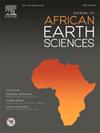南非Offshore Orange盆地2和3区块的烃源岩成熟度和1-D盆地建模
IF 2.2
4区 地球科学
Q2 GEOSCIENCES, MULTIDISCIPLINARY
引用次数: 0
摘要
南非的被动大陆边缘几乎没有勘探过,尽管Orange盆地有一定的潜力,甚至纳米比亚海上的Kudu气田和南非海上的Ibhubesi气田也证实了这一点。本研究使用烃源岩样品和盆地模型来评估南非白垩纪勘探许可区块2和3,Offshore Orange盆地。该研究的重点是烃源岩成熟度的发展,旨在理解导致奥兰治盆地形成的地质过程。这些有机矿床具有多个地层单元的平均TOC值,TOC组成相对较好,范围为0.53 ~ 1.89 wt %。在检查的23个样品中,17个样品的TOC浓度超过1%,其余6个样品的含量在0.53至0.98 wt %之间。所检测的有机沉积物的硫含量相对较低(TS, wt.%),范围在0.21 - 1.18 wt%之间,其中Turonian-Coniacian序列的硫含量略高,可达1.18 wt%。结果表明:存在游离油(S1),干酪根热裂解生成的油(S2)输送的是低含油气潜力油。页岩储层分析表明,其低含油气潜力是由S2和S3产油支持的,这与TOC含量一致。研究区平均氢指数(HI)表明烃源岩质量低,可产ⅲ型干酪根。对4口井进行了一维模拟,揭示了沉降和多重构造作用对埋藏和热史的影响,在塞诺曼—土鲁宁期最大埋藏厚度可达2110 m。通过对Orange盆地烃源岩分析与油气盆地模拟的综合研究,揭示了该盆地白垩系烃源岩具有一定的含油气潜力,在裂谷后下部有3个含油气系统,并推断出裂谷后上部的油气展布。本文章由计算机程序翻译,如有差异,请以英文原文为准。
Source rock maturity and 1-D basin modelling in blocks 2 and 3 sector, Offshore Orange Basin, South Africa
The passive continental margins of South Africa are virtually unexplored, although some potential is assumed in the Orange Basin and even proven by the Kudu gas field offshore Namibia and the Ibhubesi gas field offshore South Africa. The present research uses source rock samples and basin modelling to evaluate the hydrocarbon potential in the Cretaceous South African exploration license blocks 2 and 3, Sector, Offshore Orange Basin. With an emphasis on the development of source rock maturity, the study seeks to comprehend the geological processes that led to the formation of the Orange Basin. These organic deposits have average TOC values across the several stratigraphic units, with a relatively fair to good TOC composition ranging from 0.53 to 1.89 wt %. Out of the 23 samples that were examined, 17 had TOC concentrations of more than 1 %, and the remaining 6 had contents between 0.53 and 0.98 wt %. The examined organic sediments have a relatively low sulphur (TS, wt.%) content, ranging from 0.21 to 1.18 wt%, with the Turonian–Coniacian sequence having a slightly higher sulphur content of up to 1.18 wt%. These results show that free petroleum exists (S1) and that oil generated by kerogen heat cracking (S2) delivers oil with low petroleum potential. The analysis of the shale deposits shows that their low petroleum potential is supported by the S2 and S3 petroleum yields, which are consistent with TOC content. The average hydrogen index (HI) in the study area indicating low-source rock quality capable of producing type III kerogen. A one-dimensional simulation was constructed for four wells, which reveals subsidence and the influence of multi-tectonism on the burial and thermal history, reaching a maximum burial thickness from Cenomanian to Turonian up to 2110 m. The integrated studies between the analyses of source rocks and petroleum basin modelling from the Orange Basin reveal a certain petroleum potential of the Cretaceous source rocks and three petroleum systems in the lower post-rift pattern and an extrapolated topmost post-rift play.
求助全文
通过发布文献求助,成功后即可免费获取论文全文。
去求助
来源期刊

Journal of African Earth Sciences
地学-地球科学综合
CiteScore
4.70
自引率
4.30%
发文量
240
审稿时长
12 months
期刊介绍:
The Journal of African Earth Sciences sees itself as the prime geological journal for all aspects of the Earth Sciences about the African plate. Papers dealing with peripheral areas are welcome if they demonstrate a tight link with Africa.
The Journal publishes high quality, peer-reviewed scientific papers. It is devoted primarily to research papers but short communications relating to new developments of broad interest, reviews and book reviews will also be considered. Papers must have international appeal and should present work of more regional than local significance and dealing with well identified and justified scientific questions. Specialised technical papers, analytical or exploration reports must be avoided. Papers on applied geology should preferably be linked to such core disciplines and must be addressed to a more general geoscientific audience.
 求助内容:
求助内容: 应助结果提醒方式:
应助结果提醒方式:


